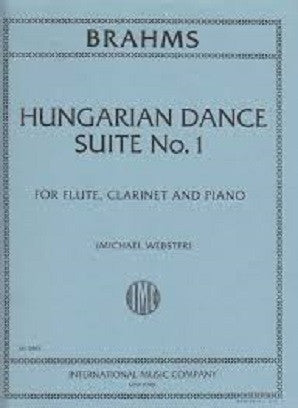Syrinx Music
Brahms Hungarian Dance Suite No. 1 Flute, Clarinet and Piano
Brahms Hungarian Dance Suite No. 1 Flute, Clarinet and Piano
Couldn't load pickup availability
For Flute, Clarinet and Piano
(MICHAEL WEBSTER)
Preface
Vienna acted as a cultural magnet for composers of the 18th and 19th centuries. Johannes Brahms was one of many who settled there, and due to proximity with Budapest, became influenced by Hungarian music.
Brahms' seminal performing experience had been as piano accompanist for the famous Hungarian violinist, Eduard Remanyi (1830 -1898), on tour during the 1852 -53 season. He brought that background with him when he moved to Vienna in 1862 and incorporated overt references to the Hungarian style in such works as the Piano Quartet in G minor, Op. 25 (1861), the Viola Quintet in G major, Op. 111 (1890) and the Clarinet Quintet in B minor, Op. 115 (1891). He also wrote 21 Hungarian Dances, published in four books, two each in 1869 and 1880, originally for piano, four hands. All of them were orchestrated by Brahms, Dvorak, and some lesser-known composers, and became immensely popular during Brahms A' lifetime.
Bittersweet is the word that best characterizes Hungarian music. It tends to be happy and sad at the same time, or to vacillate quickly between contrasting moods. Among these seven dances, chosen for their interesting key relationships and contrasting moods, only No. 14 (the shortest) does not have significant changes of tempo to dramatize quickly changing moods. Popular Hungarian dance forms are interspersed: in No. 5 and No. 13 the czardas, a fast dance in two beats, in No. 21 the sebes, an even faster dance; and in No. 16 the dumka, alternating fast and slow. Dances No. 14 and No. 13 feature three-measure phrases, and jolly No. 7 includes the A"snappedA" rhythm (quick note on the beat) in typical Hungarian fashion. Major and minor scales are often colored by raising the fourth step, creating Lydian mode in major (No. 6 and No. 7) and the A"gypsyA" scale in harmonic minor (No. 6 and No. 16). There is even reference to the Hungarian hammered dulcimer, called cimbalom, in the tremolos of No. 14.
During the century and a quarter since they were written, certain of the Hungarian Dances (such as No. 5 and No. 6) have achieved in commensurable popularity in their orchestrated versions. This set attempts to revisit the original four-hand version and bring some of the lesser-known but equally engaging dances to a wider public.
Share


